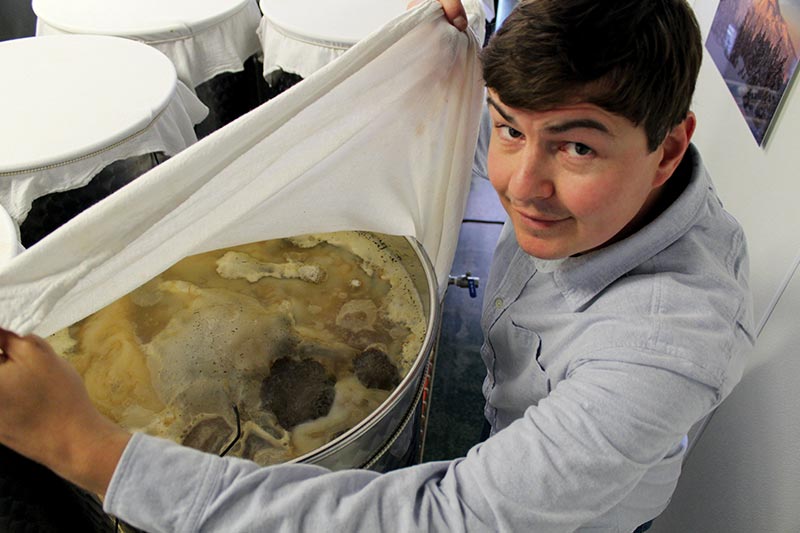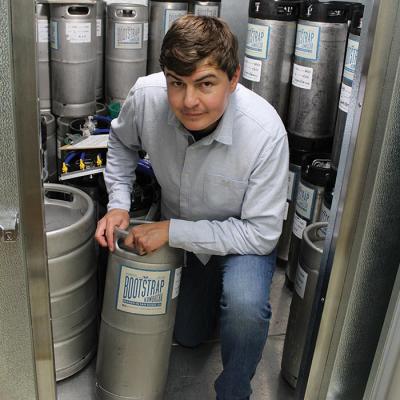Fermentation Is Sweeping the Nation. Spencer Johnson ’09 wants to prove Kombucha is more than another “curious tea.”
Story//George Thurlow ‘73 Photos//Courtesy Bootstrap Kombucha

Along the back wall of Spencer Johnson’s ’09 cozy tasting room are rows of jars that look like they are filled by creatures from another planet. Like layers of jellyfish, the gray oozy material is growing, multiplying and dividing. But this is not some horror film laboratory. This is where Kombucha is being made.
In a semi-industrial area of San Diego Johnson is brewing up the nation’s latest health kick. Though the Federal Trade Commission has issued warnings about claims of Kombucha’s health benefits, its proponents claim Kombucha has many health benefits, from high levels of vitamins B and C, to probiotic yeasts & bacteria as well as beneficial organic acids that are good for various organ functions.
Johnson is the chief marketer and salesperson and partner at Bootstrap Kombucha, the first commercial Kombucha maker brewery to set up shop in San Diego some years ago. Many believe Kombucha fermenting will follow the trend of the craft brew industry in San Diego, considered one of the early hotspots for craft brewing.
“Ours is a simple and elegant Kombucha,” he explains while serving samples of Bootstrap’s more than a dozen flavors, from lavender to the newest one from the small experimental kitchen: a collaboration with his former Isla Vista roommate & UCSB Alumnus Belisario Dimuzio (Bacterial Pathogenesis ’09) a “Bloody Mary” Kombucha. All of Bootstrap’s Kombuchas are served fresh from the keg while many Kombuchas found on store shelves have developed off flavors from sitting out so long.
Pointing to the 50-gallon tanks where several batches of Kombucha are fermenting, Johnson decried many shelf kombuchas as either turning too quickly to vinegar, or being mixed with sugar to cover the quickly deteriorating flavor. “We control the process so that we are delivering the best possible product,” Johnson said. It is only available in the tasting room, where growlers are sold, or in a small number of cafes, bars and restaurants where it is sold fresh. Bootstrap’s Kombucha is non-alcoholic.

The history of Kombucha is as murky as the fermenting beverage. It is known that Kombucha was brewed in eastern China and Western Russia at least 200 years ago, but where the SCOBY, a symbiotic culture of bacteria and yeast (SCOBY), originated from and how it came to be may never be known. Since it normally contains less than 0.5% alcohol, it is not regulated by the government as an alcohol product. By some estimates $1 billion a year of Kombucha is sold in the U.S..
At Bootstrap Johnson describes the three variations of Kombucha products they brew, each of which can then be flavored with a myriad of organic fruits, roots, flowers, spices, etc. There is a black tea base with a big flavor; an oak aged line from which “interesting” flavors can be created from the tannins in the tea leaves; and a green tea blend which is “very light and refreshing.”
The process begins with the steeping of various types of teas with the leaves discarded, sugar added, and (SCOBY) being introduced. The fermentation process consumes almost all the sugar and 2/3 of the caffeine. This mixture is allowed to sit for up to two weeks fermenting until the ideal pH level is reached at which point the liquid is transferred to the individual kegs.
Johnson majored in geography at UCSB and “loved all types of science.” His career began in sales though he had wanted to join the burgeoning craft beer industry. Eventually, after becoming a consummate salesperson, he landed a job at a brewery. He recalled telling the recruiter that he had to be snappy because in his sales job at the time he was expected to make 70 in-person cold calls a day.
After working all across the state of California in the beer business he was recruited by tech industry veterans James Farnworth and Susan McMillion who had home brewed Kombucha and had started a small business crafting unique flavors and varieties.
Noting that most people have heard of Kombucha, Johnson’s mission is to educate them on the benefits of fresh versus store shelf Kombucha. “This is not a miracle cure drink,” he explained. “But it’s like eating spinach versus eating French fries every day. It is a great part of a well balanced lifestyle.”
But he bemoans the fact that so much more research could be done about the complex yeast and bacteria relationships during the fermentation of Kombucha and the possible health benefits of all the various components in the final product. “We got to get UCSB in here,” he said with a laugh.
Like so many of his fellow Gauchos, Johnson attributes his engaging, enthusiastic style to UCSB. “The social skills I have come from a well-balanced liberal education.”